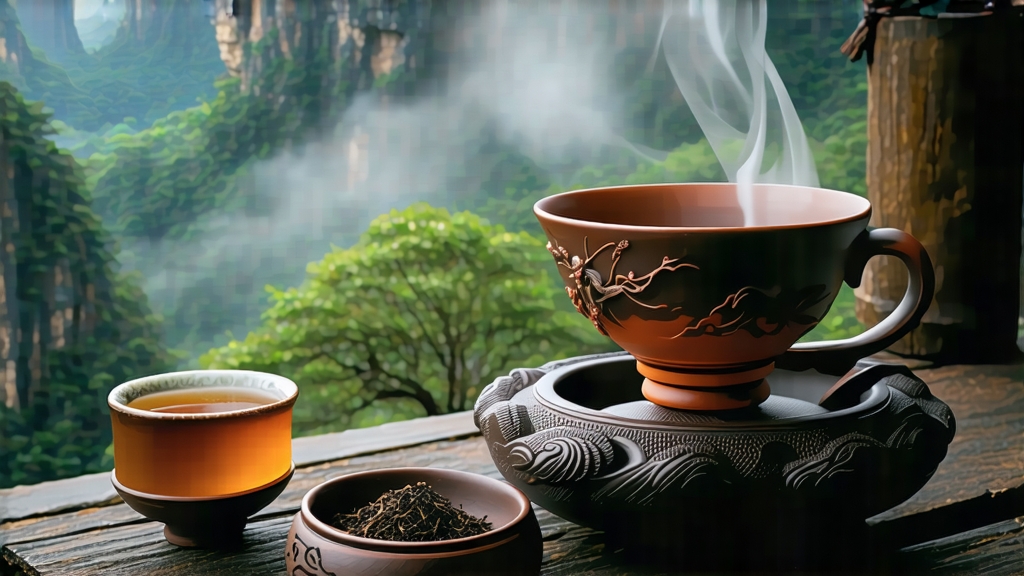
High in the mist-curtained Wuyi Mountains of northern Fujian, a narrow plank path clings to sheer cliffs that drop into the Jiuqu Xi, the “Nine-Bend Stream.” Here, where weathered igneous rock meets subtropical humidity, grows the most mythologized oolong on earth—Da Hong Pao, literally “Big Red Robe.” International drinkers often meet it first through airport gift boxes, yet the true leaf is a living dialogue between Jurassic geology, Song-dynasty monks, Qing-era scholars, and 21st-century micro-roasters. To sip authentic Wuyi Da Hong Pao is to taste the mineral pulse of a UNESCO dual heritage site and the smoky memory of centuries-old charcoal pits.
The origin story is half history, half opera. In 1385, so the tale goes, a Ming imperial scholar en route to the capital collapsed with fever on the Wuyi trail. Monks from the Tianxin Temple brewed leaves plucked from six shrubby trees growing out of a cleft in the cliff. The scholar revived, continued to Beijing, topped the imperial exams, and returned in crimson robes to thank the trees by draping his robe over them—hence the name. Whether apocryphal or not, the six “mother trees” still stand in Jiulong Ke, now protected since 2006 when the Chinese government halted all plucking to preserve their genetic legacy. Cuttings taken in the 1980s created the vast clonal gardens that supply today’s market, yet the mystique of the “mother tree” endures, pushing prices of remaining 20-gram auction lots past USD 30,000.
Botanically, Da Hong Pao belongs to the Wuyi qi zhong (“strange cultivar”) family, a subgroup of Camellia sinensis var. sinensis adapted to thin, mineral-rich soils. The most prized clones—Que She (“Sparrow Tongue”), Bei Dou #1, and Qi Dan—carry distinct aromatic signatures: Que She leans toward white-peach and iris, Bei Dou #1 toward toasted almond and cacao, Qi Dan toward narcissus and flint. Traditionalists insist that only tea grown within the 60 km² core scenic zone possesses yan yun, the elusive “rock rhyme” that manifests as a cooling, mentholated finish and a tactile sensation Chinese tasters call “bone”—a structured, almost architectural grip on the palate.
Crafting Da Hong Pao is a month-long choreography of stress and rest. Picking occurs in late April when leaves reach the “small to medium open” standard: three or four semi-mature leaves with a 4–6 cm petiole. Under the noon sun, pickers pinch the stem with a downward flick that bruises the node—an intentional micro-wound that starts enzymatic oxidation. The baskets are rushed to the factory where the first of four withering stages begins: sun withering on bamboo screens for 20–30 minutes until the leaf edges warm to 38 °C, then indoor rack withering where fans simulate the cool gorge wind.
What follows is the signature yao qing, “rocking green,” a labor-intensive shaking in rattan drums every hour from dusk to dawn. Masters listen for the rustle that shifts from crisp to velvet—an acoustic cue that cell walls are rupturing and aromatic precursors are marrying. At 3 a.m., when the leaf’s rim turns crimson and the inner leaf jade, they fire it in a 280 °C electric drum for three minutes to arrest oxidation at 30–40 %, the sweet spot for oolong.
Yet the soul of Da Hong Pao is its charcoal roasting. Traditionally done in the lunar month of August, when ambient humidity drops, tea is loaded into 60 cm diameter bamboo baskets nested over a pit of glowing lychee or longan wood embers. The fire must never flame, only breathe. Roasters alternate between high “killing” heat (120 °C) and gentle “nursing” heat (80 °C), turning the baskets every 20 minutes for 8–12 hours. This cycle is repeated two to four times over three months, allowing the leaf to rest and re-absorb ambient moisture between roasts. The result is a dark, ribbon-like leaf that smells of burnt caramel and warm stone, yet when brewed reveals a liquor the color of antique amber.
To brew Da Hong Pao gongfu style, begin with a 100 ml gaiwan or small Y